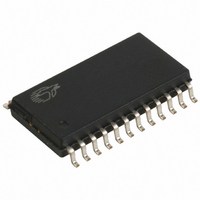CY7C63613-SC Cypress Semiconductor Corp, CY7C63613-SC Datasheet - Page 6

CY7C63613-SC
Manufacturer Part Number
CY7C63613-SC
Description
IC MCU 8K USB LS MCU 24-SOIC
Manufacturer
Cypress Semiconductor Corp
Series
M8™r
Datasheet
1.CY7C63613-SC.pdf
(30 pages)
Specifications of CY7C63613-SC
Applications
USB Microcontroller
Core Processor
M8B
Program Memory Type
OTP (8 kB)
Controller Series
CY7C636xx
Ram Size
256 x 8
Interface
PS2, USB
Number Of I /o
16
Voltage - Supply
4 V ~ 5.5 V
Operating Temperature
0°C ~ 70°C
Mounting Type
Surface Mount
Package / Case
24-SOIC (7.5mm Width)
Lead Free Status / RoHS Status
Contains lead / RoHS non-compliant
Other names
428-1321
Available stocks
Company
Part Number
Manufacturer
Quantity
Price
Company:
Part Number:
CY7C63613-SC
Manufacturer:
CYP
Quantity:
5 510
Part Number:
CY7C63613-SC
Manufacturer:
CYPRESS/赛普拉斯
Quantity:
20 000
FOR
FOR
PRELIMINARY
CY7C63612/13
2.0
Functional Overview
The CY7C63612/13 are 8-bit RISC One Time Programmable (OTP) microcontrollers. The instruction set has been optimized
specifically for USB operations, although the microcontrollers can be used for a variety of non-USB embedded applications.
The CY7C63612/13 features 16 General-Purpose I/O (GPIO) pins to support USB and other applications. The I/O pins are
grouped into three ports (Port 0, 1, and 3) where each port can be configured as inputs with internal pull-ups, open drain outp uts,
or traditional CMOS outputs. 12 GPIO pins (Ports 0 and 1) are rated at 7 mA typical sink current. There are 4 GPIO pins (Port 3)
which are rated at 12 mA typical sink current, which allows these pins to drive LEDs. Multiple GPIO pins can be connected together
to drive a single output for more drive current capacity. Additionally, each I/O pin can be used to generate a GPIO interrupt to the
microcontroller. Note the GPIO interrupts all share the same “GPIO” interrupt vector.
The Cypress microcontrollers use an external 6-MHz ceramic resonator to provide a reference to an internal clock generator. This
clock generator reduces the clock-related noise emissions (EMI). The clock generator provides the 6- and 12-MHz clocks that
remain internal to the microcontroller.
The CY7C63612/13 are offered with two EPROM options to maximize flexibility and minimize cost. The CY7C63612 has 6 Kbytes
of EPROM. The CY7C63613 has 8 Kbytes of EPROM.
These parts include power-on reset logic, a watch dog timer, a vectored interrupt controller, and a 12-bit free-running timer. The
Power-On Reset (POR) logic detects when power is applied to the device, resets the logic to a known state, and begins executing
instructions at EPROM address 0x0000h. The watch dog timer can be used to ensure the firmware never gets stalled for more
than approximately 8 ms. The firmware can get stalled for a variety of reasons, including errors in the code or a hardware failure
such as waiting for an interrupt that never occurs. The firmware should clear the watchdog timer periodically. If the watch dog
timer is not cleared for approximately 8 ms, the microcontroller will generate a hardware watch dog reset.
The microcontroller supports eight maskable interrupts in the vectored interrupt controller. Interrupt sources include the USB Bus-
Reset, the 128- s and 1.024-ms outputs from the free-running timer, three USB endpoints, the DAC port, and the GPIO ports.
The timer bits cause an interrupt (if enabled) when the bit toggles from LOW “0” to HIGH “1”. The USB endpoints interrupt after
either the USB host or the USB controller sends a packet to the USB. The DAC ports have an additional level of masking that
allows the user to select which DAC inputs can cause a DAC interrupt. The GPIO ports also have a level of masking to select
which GPIO inputs can cause a GPIO interrupt. For additional flexibility, the input transition polarity that causes an interrupt is
programmable for each pin of the DAC port. Input transition polarity can be programmed for each GPIO port as part of the port
configuration. The interrupt polarity can be either rising edge (“0” to “1”) or falling edge (“1” to “0”).
The free-running 12-bit timer clocked at 1 MHz provides two interrupt sources as noted above (128- s and 1.024-ms). The timer
can be used to measure the duration of an event under firmware control by reading the timer twice: once at the start of the event,
and once after the event is complete. The difference between the two readings indicates the duration of the event measured in
microseconds. The upper four bits of the timer are latched into an internal register when the firmware reads the lower eight bits.
A read from the upper four bits actually reads data from the internal register, instead of the timer. This feature eliminates the need
for firmware to attempt to compensate if the upper four bits happened to increment right after the lower 8 bits are read.
The CY7C63612/13 include an integrated USB serial interface engine (SIE) that supports the integrated peripherals. The hard-
ware supports one USB device address with three endpoints. The SIE allows the USB host to communicate with the function
integrated into the microcontroller.
Finally, the CY7C63612/13 support PS/2 operation. With appropriate firmware the D+ and D– USB pins can also be used as PS/
2 clock and data signals. Products utilizing these devices can be used for USB and/or PS/2 operation with appropriate firmware.
6











